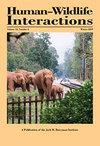Evaluation of Damage to Forest Tree Plantations by Wild Boar in the Czech Republic
IF 0.9
4区 环境科学与生态学
Q4 BIODIVERSITY CONSERVATION
引用次数: 2
Abstract
Wild boar (Sus scrofa) populations in Central Europe have been growing longterm, and damages to crops and forests where boars damage freshly planted tree seedlings are growing too. In addition to having a significant economic impact, these damages worsen the prospect of successful restoration of bare land. This study presents an analysis of damage to tree seedling plantations caused by wild boar in the Czech Republic. We used data from an extensive questionnaire survey among forest owners, our own survey of the extent of damage in model areas, and experiments in locations with a large boar population. Damage to plantings is a widespread phenomenon, and up to 80% of planted trees may be damaged in heavily affected locations. The wild boar does not differentiate between bareroot or containerized seedlings or tree species. Trees were often simply pulled out, without any traces of damage to the root system. Wild boar preferences were not affected by the composition of the substrate of containerized seedlings. Seedlings were damaged most often during the 4 weeks after planting; after this period, the risk of damage fell considerably. Based on the obtained data, we estimated that the damage caused by wild boar rooting out seedlings in 2019 throughout the Czech Republic amounted to $3,199,200 USD, which is equivalent to $122 USD per km2 of forest land. As we are not currently aware of any method of protection against this damage, the most expedient solution seems to be the reduction of the wild boar population, as well as to monitor and protect freshly established cultures, for a period of at least 4 weeks after planting.捷克共和国野猪对林木人工林的危害评价
在中欧,野猪(Sus scrofa)的数量一直在增长,野猪对农作物和森林的破坏也在增加,野猪对新种植的树苗的破坏也在增加。除了具有重大的经济影响外,这些损害还使成功恢复裸地的前景恶化。本研究分析了捷克共和国野猪对树苗人工林造成的危害。我们使用的数据来自对森林所有者的广泛问卷调查,我们自己对模型区域损害程度的调查,以及在野猪种群众多的地方进行的实验。对植物的破坏是一种普遍现象,在受影响严重的地区,高达80%的种植树木可能受损。野猪不区分裸根或容器苗或树种。树木通常被简单地拔了出来,根系没有任何损伤的痕迹。野猪的偏好不受容器苗基质组成的影响。幼苗在播种后4周内受损最严重;在此之后,损失的风险大大降低。根据获得的数据,我们估计2019年整个捷克共和国野猪根苗造成的损失为3199200美元,相当于每平方公里林地122美元。由于我们目前还不知道任何防止这种损害的方法,最权宜的解决方案似乎是减少野猪数量,并在种植后至少4周内监测和保护新建立的栽培。
本文章由计算机程序翻译,如有差异,请以英文原文为准。
求助全文
约1分钟内获得全文
求助全文
来源期刊

Human–Wildlife Interactions
Environmental Science-Nature and Landscape Conservation
CiteScore
2.80
自引率
0.00%
发文量
0
审稿时长
11 weeks
期刊介绍:
Human–Wildlife Interactions (HWI) serves the professional needs of the wildlife biologist and manager in the arena of human–wildlife conflicts/interactions, wildlife damage management, and contemporary wildlife management. The intent of HWI is to publish original contributions on all aspects of contemporary wildlife management and human–wildlife interactions with an emphasis on scientific research and management case studies that identify and report innovative conservation strategies, technologies, tools, and partnerships that can enhance human–wildlife interactions by mitigating human–wildlife conflicts through direct and indirect management of wildlife and increased stakeholder engagement. Our intent is to promote a dialogue among wildlife professionals concerning contemporary management issues. As such, we hope to provide a repository for wildlife management science and case studies that document and share manager experiences and lessons learned.
 求助内容:
求助内容: 应助结果提醒方式:
应助结果提醒方式:


